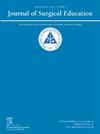Changes in Matches into Surgical Residencies and Fellowships Following the ACGME Merger
IF 2.6
3区 医学
Q1 EDUCATION, SCIENTIFIC DISCIPLINES
引用次数: 0
Abstract
Objective
In 2015, a transition was initiated among the Accreditation Council for Graduate Medical Education (ACGME), American Osteopathic Association (AOA), and American Association of Colleges of Osteopathic Medicine (AACOM), resulting in a single accrediting body for residencies and fellowships as of 2020. This study aims to elucidate whether this had an impact on osteopathic students' matching into general surgery residencies, integrated surgery residencies, and surgical fellowships.
Design, Setting, and Participants
Using the Results and Data Residency Match data file and the Results and Data: Specialties Matching Service data from the National Resident Matching Program from 2015 to 2024, data was extracted regarding osteopathic and allopathic match rates into general surgery residency and surgical fellowships, respectively. Applicants were grouped on matching in 2015-2019 (premerger) or 2020-2024 (postmerger). Statistical analysis using the Chi-Square test was performed to determine if there was a significant difference in the mean number of matches in the pre and postmerger groups (p < 0.05).
Results
Postmerger, the proportion of osteopathic students matching into general surgery residency increased significantly (DO, 5.77% vs 14.25%, p = 0.032). However, the proportion of osteopathic students who matched into integrated residencies, such as thoracic, plastic, and thoracic surgery, did not increase (p > 0.05). For surgical fellowships, there was no significant increase in the proportion of osteopathic students matching (DO, 6.36% vs 9.59%, p = 0.389). Independently, an increase was seen in osteopathic matches across fellowships; however, it was only significant for vascular (8.16% vs 14.17%, p = 0.013) and hand surgery (3.79% vs 5.86%, p = 0.019).
Conclusions
Postmerger, there was an increase in osteopathic students and physicians filling general surgery residency, vascular, and hand surgery fellowship positions. However, the proportion of osteopathic students who matched into integrated surgery residencies remained the same.
求助全文
约1分钟内获得全文
求助全文
来源期刊

Journal of Surgical Education
EDUCATION, SCIENTIFIC DISCIPLINES-SURGERY
CiteScore
5.60
自引率
10.30%
发文量
261
审稿时长
48 days
期刊介绍:
The Journal of Surgical Education (JSE) is dedicated to advancing the field of surgical education through original research. The journal publishes research articles in all surgical disciplines on topics relative to the education of surgical students, residents, and fellows, as well as practicing surgeons. Our readers look to JSE for timely, innovative research findings from the international surgical education community. As the official journal of the Association of Program Directors in Surgery (APDS), JSE publishes the proceedings of the annual APDS meeting held during Surgery Education Week.
 求助内容:
求助内容: 应助结果提醒方式:
应助结果提醒方式:


